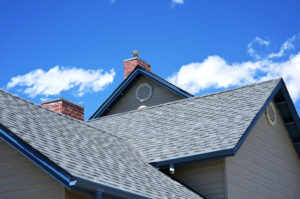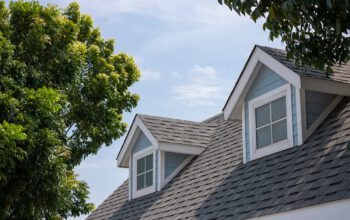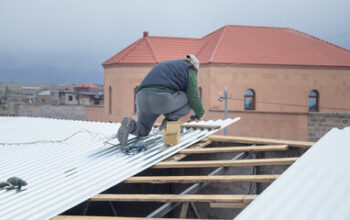Roofing are the roof coverings that protect against rain, snow, sunlight, wind, and extreme temperatures. It can also add to the beauty and value of a home.
Roofing structures vary by material and architectural style. Some common types of roofing include shingles, cedar shakes, slate, and tile. Depending on the type of roof, the structure may require different reinforcement.
When considering a new roof or replacement, homeowners should be aware of the many factors that can affect cost. Roofing contractors typically base their estimates on the number of “roofing squares,” which are 10-foot by 10-foot sections or 100 square feet. This unit of measure makes it easier for roofers to calculate materials, supplies, protective elements, and waste removal costs. Homeowners should ask their roofing contractor to explain this unit of measurement if they are not familiar with it.
The type of roofing material is one of the largest contributors to the overall cost. Basic asphalt shingles cost about $2,000 per square, while more luxurious shingle types and alternate materials may cost up to $40,000. The choice of roofing material will also impact the price of repair or maintenance.
Another major factor is labor. The cost of reroofing will vary depending on the area where the home is located and the local labor rates. In addition, homeowners should plan on having to pay for a building permit, which will add to the overall project cost.
Lastly, any existing features or penetrations on the roof can increase the total project cost. For example, chimneys and skylights are potential leak points that require special sealing techniques and additional time. In addition, plumbing pipes and electrical penetrations must be sealed and rerouted during the roof installation process. These factors can add up quickly and increase the overall cost of the roof. If you are re-roofing, including a 10% contingency for these unexpected costs is important.
Materials
A roof protects a building from rain, sunlight, snow and extreme temperatures. It can be made of a variety of materials, depending on geographic location and design requirements. The most common roofing materials are asphalt shingles, wood shingle and metal. In addition to these traditional options, there are also newer membrane roofing products that can be rolled on the roof and adhesives for a leak barrier.
Before starting your roof project, it’s a good idea to have the proper tools for the job. A good hammer and nail gun are essential for installing shingles, along with a utility knife to cut the shingle and underlayment material to size. A chalk line is also a great tool to have on hand, especially when installing open valleys or aligning gutters. A standard chalk reel isn’t too expensive and you will only need one that contains replacement chalk for your entire roof installation.
Among the more traditional types of roofing materials are wood shingles and shakes, which add a rustic look to any home. They are a cost-effective choice, with prices that range from $4 to $9 per square foot. However, they are not as durable as some other roofing materials, and they may be difficult to install in areas prone to wildfires or heavy moisture.
If you’re looking for a roofing material that’s more sustainable, rubber is an excellent option. It’s available in a wide variety of colors and can be manufactured to mimic other roofing materials, such as slate or asphalt shingles. It’s also fairly durable, with a lifespan of over 50 years if properly maintained. However, it has a distinctive odor and doesn’t provide the same insulation as other roofing materials.
Other roofing materials include tar, felt and EPDM roof membranes. EPDM stands for ethylene-propylene-diene monomer, and these single-sheet membranes can be either nonreinforced or reinforced with fabric. They can be loose laid, mechanically fastened or fully adhered to nailable or nonnailable decks. They’re highly resistant to degradation from certain chemicals and the ozone.
Another popular type of roof is a built-up bituminous roof, which requires professional installation. It consists of a base sheet, two or more reinforcing felt ply sheets and a surfaced cap sheet. During installation, the layers are heated to fuse the saturating bitumen and surfacing materials together.
Installation
Before hiring a roofer, ask for references and make sure they’re licensed, insured, bonded, and Better Business Bureau-rated. You should also check for manufacturer-recommended contractors. Those credentialed have gone through more training in installing their products. You can also ask your homeowners insurance company for a list of its recommended contractors.
Roofing requires a ladder and safety gear, including a harness and work gloves. It’s helpful to have a chalk reel, which snaps and applies chalk lines for open valleys and aligning gutters. These are relatively inexpensive and come with replacement chalk, which is essential for roofing because you snap chalk lines frequently.
Besides shingles, you need felt paper and underlayment for your roof. You’ll also need flashing, which seals areas around chimneys and where roof planes meet. Waterproofing your valleys, which are “V” shaped areas in the roof, is important because this is where most water runs through.
Maintenance
A roof requires regular maintenance to ensure it is performing well and not leaking. Some of the more obvious problems can be addressed by facility staff, and others will need to be addressed by professional roofing contractors. For example, removing debris from the surface of the roof is important to prevent water accumulation that can damage the underlying materials. In addition, the drain lines should be cleaned regularly to ensure that water can flow freely through the roof system. In some cases, a clogged drain line can cause localized ponding that can prematurely damage the roof. Another important area to check is the caulking around penetrations and perimeter flashings, as leaks are often caused by these issues.
Other areas to inspect include the chimney and the flashings that seal the area between roof planes. These should be inspected for cracking and looseness on an annual basis, and caulk should be replaced as needed. In addition, examining the ridge caps for signs of deterioration is important, as they can allow water to seep into and under the shingles or tiles.
Lastly, the large accessories such as skylights and vent outlets should be inspected for rust and other signs of wear and tear. Cleaning these items is not a fun job, but it is necessary to maintain the longevity of the roof system. In addition, trimmed tree branches that hang over the roof should be inspected on an annual basis to ensure they are not causing damage during storms or other weather conditions.
It is a good idea to call your home insurance company or agent to find out how your policy addresses repair and replacement costs for damage caused by a natural disaster incident or severe weather event. Having this information in hand can help minimize out-of-pocket expenses when it comes to the repair or replacement of a roof.


